Topics
Category
Era
First Minnesota Volunteer Infantry Regiment
Painting of the First Minnesota Volunteer Infantry Regiment at the Battle of Gettysburg by Rufus Zogbaum, 1907. The painting is in the Governor's Reception Room at the Minnesota State Capitol.
The First Minnesota Volunteer Infantry Regiment holds a special place in the history of Minnesota. It was the first body of troops raised by the state for Civil War service, and it was among the first regiments of any state offered for national service.
As part of the Union Army of the Potomac, the First Minnesota saw action in most of the major battles in the war's Eastern Theater, which included the states of Virginia, Maryland and Pennsylvania, among others. The First Minnesota won a reputation as a hard-fighting regiment, particularly after its dramatic, sacrificial action at the Battle of Gettysburg in July 1863. After the war, the First Minnesota became legendary and a symbol of the Civil War service of all Minnesotans.
Minnesota Governor Alexander Ramsey made his tender of 1,000 men for national service on April 14, 1861, the day after the surrender of Fort Sumter in South Carolina. Within two weeks, the First Minnesota Volunteer Infantry Regiment was filled with 1,009 men from St. Paul and nearby towns. Such was the patriotic fervor of Minnesota, which had become a state just a few years earlier, in 1858. The First Minnesota mustered for duty at Fort Snelling on April 29, 1861. By the Fourth of July, its soldiers were stationed in Alexandria, Virginia, where they continued their training under the command of Colonel Willis A. Gorman.
The First Minnesota participated in many of the Civil War's early battles, since it was among the first regiments in service. During 1861, it was heavily engaged at the First Battle of Bull Run (July 21) and took part in the Battle of Balls Bluff (October 21). In May through July of 1862, as part of the First Brigade, Second Division, Second Corps of the Army of the Potomac, the First Minnesota took part in the Peninsula Campaign and the Seven Days Battles near Richmond, Virginia. It also fought at Antietam in Maryland (September 16–17), suffering significant losses in that battle.
Although present at the battles of Fredericksburg (December 11–15, 1862) and Chancellorsville (April 30–May 6, 1863) in Virginia, the First Minnesota was not actively involved in the fighting there. The Battle of Gettysburg in Pennsylvania was another story, however. That battle (July 1–3, 1863) proved to be the First Minnesota's most noteworthy action.
On July 2, 1863, the second day of fighting at Gettysburg, the First Minnesota helped General Winfield S. Hancock hold the Union line against advancing Confederate soldiers. Outnumbered three or four to one, the First Minnesota fought the Confederates at close range over 300 yards of open ground near Cemetery Ridge. The next day, the First Minnesota contributed to the repulse of Pickett's Charge, which effectively ended the Battle of Gettysburg and served as a turning point in the war. Two soldiers from the First Minnesota, Corporal Henry O'Brien and Private Marshall Sherman, received the Congressional Medal of Honor for their actions that day. But the regiment's fighting at Gettysburg came at a cost: hundreds of Minnesota soldiers died or were wounded, and the regiment was nearly destroyed.
Through the remaining months of 1863, the First Minnesota helped to quell the New York City Draft Riots (July 13–16) and spent a few restful weeks camped on Governors Island in Manhattan and in Washington Park in Brooklyn. In the fall, the regiment participated in its last fights: the Battle of Bristoe Station (October 14) and the Mine Run Campaign (November 27–December 2).
With reduced numbers and soldiers unwilling to reenlist under a new commanding officer, the First Minnesota was unable to continue as a reenlisted regiment of "veteran volunteers." In February 1864, the First Minnesota headed home. Its surviving 16 officers and 309 enlisted men were treated as returning heroes in the towns along their way. They arrived in St. Paul on February 16 to a rousing reception. After a thirty-day furlough, the First Minnesota reassembled at Fort Snelling. On April 28, exactly three years after many of its men had enlisted, the First Minnesota held its final parade and was dismissed from service.
Bibliography
Leehan, Brian. Pale Horse at Plum Run: The First Minnesota at Gettysburg. St. Paul: Minnesota Historical Society Press, 2002.
Lochren, William. "Narrative of the First Regiment." In Minnesota in the Civil and Indian Wars, 1861–1865, vol. 1, 1–78. St. Paul: Minnesota Historical Society Press, 2005.
Moe, Richard. The Last Full Measure: The Life and Death of the First Minnesota Volunteers. St. Paul: Minnesota Historical Society Press, 2001.
Related Resources
Primary
First Minnesota Infantry Regiment Letters and Research Files
Manuscript Collection, Minnesota Historical Society, St. Paul
http://www2.mnhs.org/library/findaids/00509.xml
Description: Photocopies and typed transcripts of letters, diaries, reminiscences, newspaper reports, biographical data, obituaries, and other material collected by Richard Moe for The Last Full Measure, his Civil War history of the men of the First Minnesota Infantry Regiment.
Records of Governor Alexander Ramsey, 1860–1863
Minnesota State Archives, Minnesota Historical Society, St. Paul
http://www2.mnhs.org/library/findaids/gov016.xml
Description: Includes accounting records; records concerning both civil and military appointments; letters received; records relating to pardons and other criminal matters; and petitions. There is substantial documentation of military affairs, especially concerning Minnesota regiments in the Civil War and the US-Dakota War of 1862.
Records of the First Minnesota Volunteer Infantry, 1861–1865
Minnesota State Archives, Minnesota Historical Society, St. Paul
http://www2.mnhs.org/library/findaids/adjg006.pdf
Description: From the Office of the Minnesota Adjutant General. Includes a descriptive book, morning reports, orders, a letterbook, post guard reports, proceedings of the regimental council, medical records, and miscellaneous reports of the First Minnesota Volunteer Infantry during the Civil War.
Willis A. Gorman and Family Papers, 1847–1899
Manuscript Collection, Minnesota Historical Society, St. Paul
http://www2.mnhs.org/library/findaids/P1766.xml
Description: Correspondence, business and legal papers, a volume relating to the Fourth Regiment of the Indiana Infantry, and miscellaneous papers relating to the family of Willis A. Gorman, a Minnesota territorial governor and a colonel (1861-1863) in the First Minnesota Volunteer Infantry.
P615
Regimental Records, Minnesota Infantry Regiment, 1st (1861–1864)
Manuscripts Notebooks Collection, Minnesota Historical Society, St. Paul
Description: Regimental record books and miscellany; records of companies B, C, D, and G.
Secondary
Carley, Kenneth. Minnesota in the Civil War: An Illustrated History. St. Paul: Minnesota Historical Society Press, 2000.
Hage, Anne A. "The Battle of Gettysburg as Seen by Minnesota Soldiers." Minnesota History 38 no. 6 (June 1963): 245–257
http://collections.mnhs.org/mnhistorymagazine/articles/38/v38i06p245-257.pdf
Longacre, Edward G., ed. " 'Indeed We Did Fight': A Soldier's Letters Describe the First Minnesota Regiment Before and During the First Battle of Bull Run." Minnesota History 47, no. 2 (Summer 1980): 63–70.
http://collections.mnhs.org/MNHistoryMagazine/articles/47/v47i02p063-070.pdf
Osman, Stephen E. "Minnesota in the Civil War, 1861–1866: A Bibliography of Published Sources." Unpublished manuscript, 2006.
http://www2.mnhs.org/library/findaids/lb00051/lb00051-000001.pdf
Roberts, Kate. Minnesota 150: The People, Places, and Things that Shape Our State. St. Paul: Minnesota Historical Society Press, 2007.
Smith, Hampton. "Resources for Civil War History at the Minnesota Historical Society." Unpublished manuscript, 1998.
http://collections.mnhs.org/cms/web5/media.php?pdf=1&irn=10169771
Wright, James A. No More Gallant a Deed: A Civil War Memoir of the First Minnesota Volunteers, edited by Steven J. Keillor. St. Paul: Minnesota Historical Society Press, 2001.
Web
The Historic Fort Snelling. The Civil War (1861–1865).
http://www.historicfortsnelling.org/history/military-history/civil-war
Minnesota Historical Society. Civil War Programs.
Originally found at: http://sites.mnhs.org/civil-war/
Minnesota Historical Society. Research Guide: First Minnesota Infantry.
http://libguides.mnhs.org/first_infantry
Minnesota Historical Society. The Battle Flags of Minnesota.
Originally found at: http://collections.mnhs.org/battleflags/
Related Video
Call to Arms: Minnesota Steps Forward—1861
Governor Alexander Ramsey was in Washington, DC, at the outbreak of war. Jayne Becker (Alexander Ramsey House) explores his motivations to volunteer troops and Wayne Jorgenson (author and collector) explores the motivations of the men, from across the young state, who took up arms in defense of the Union.
More Information
Related Audio
MN90: Minnesota's Civil War Mettle
MN90 producer Marisa Helms describes the creation of the First Minnesota Volunteer Infantry Regiment in 1861 and highlights its actions at the Battle of Gettysburg in 1863. Includes an interview with Matthew Cassady of Historic Fort Snelling.
All rights reserved
Holding Location
More Information
Related Images
The Army of Northern Virginia Confederate battle flag of the Twenty-eighth Virginia Volunteer Infantry Regiment. Captured by Private Marshall Sherman of St. Paul while serving with the First Minnesota Volunteer Infantry Regiment, Company C, during Pickett's Charge at the Battle of Gettysburg on July 3, 1863.
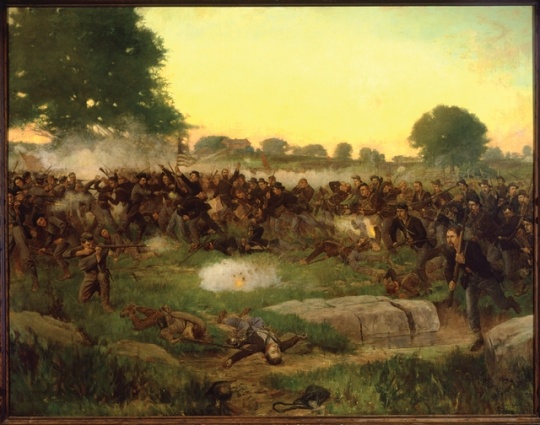
Battle of Gettysburg oil painting by Rufus Zogbaum
Painting of the First Minnesota Volunteer Infantry Regiment at the Battle of Gettysburg by Rufus Zogbaum, 1907. The painting is in the Governor's Reception Room at the Minnesota State Capitol.
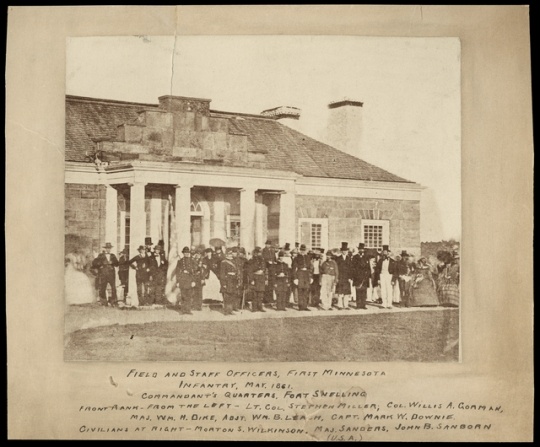
Officers of the First Minnesota Volunteers
Officers of the First Minnesota Volunteers standing in front of the commandant's house at Fort Snelling, May, 1861.
Holding Location
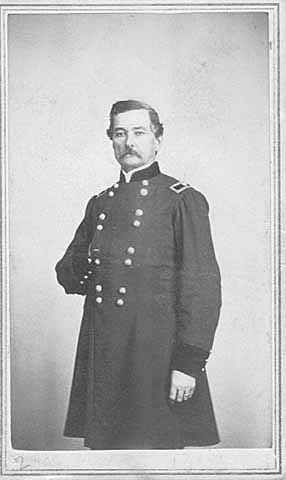
Willis Arnold Gorman, Brigadier General, First Minnesota Infantry
Willis Arnold Gorman, Brigadier General, First Minnesota Infantry, 1861. Photograph by Whitney's Gallery.
Public domain
Holding Location
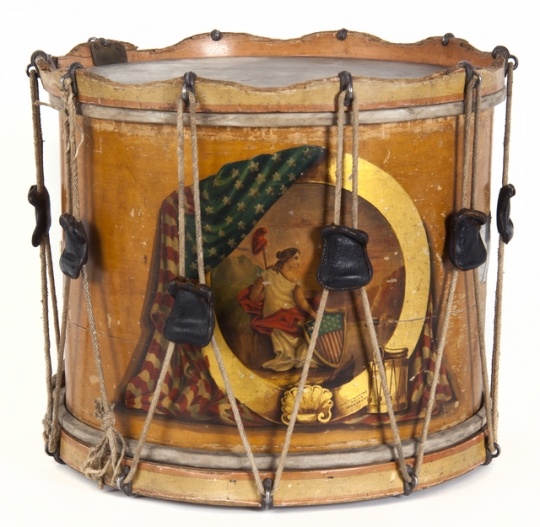
First Minnesota Regiment Civil War snare drum
First Minnesota Regiment Civil War snare drum made in 1861.
All rights reserved
Holding Location
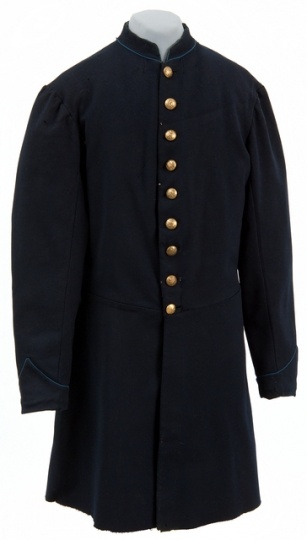
Blue wool "nine-button" Civil War frock coat
Blue wool "nine-button" frock coat worn by First Sergeant Mathew Marvin during the Civil War. Marvin served with the First Minnesota Volunteer Infantry Regiment, Company K, 1861-1864.
All rights reserved
Holding Location
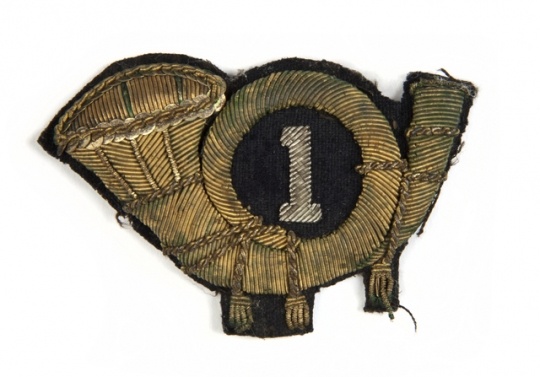
First Minnesota officer's hat insignia
First Minnesota officer's hat insignia, c.1861. Worn by William H. Dike of the First Minnesota Volunteer Infantry Regiment, Company G.
All rights reserved
Holding Location
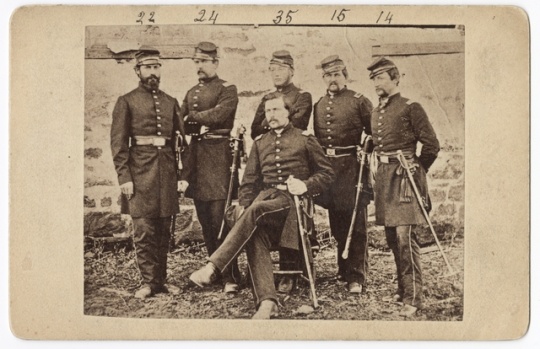
Officers of the First Minnesota Volunteers at Camp Stone
Captain Mark Downie (seated) and officers of Compnay B, First Minnesota Volunteers at Camp Stone near Edwards Ferry, Virginia, March 16, 1862. Photograph by Matthew B. Brady.
Public domain
Holding Location
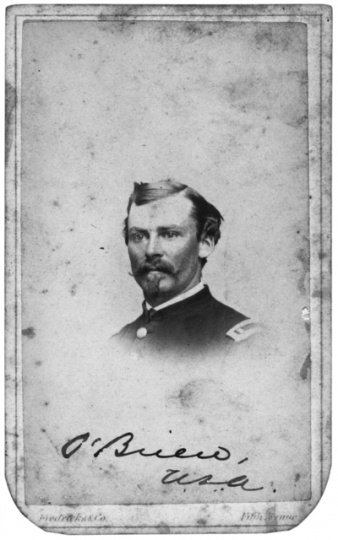
Henry D. O'Brien, First Lieutenant, First Battalion, Minnesota Infantry Volunteers
Henry D. O'Brien, First Lieutenant, First Battalion, Minnesota Infantry Volunteers, 1864. Photograph by Fredricks and Company.
Holding Location
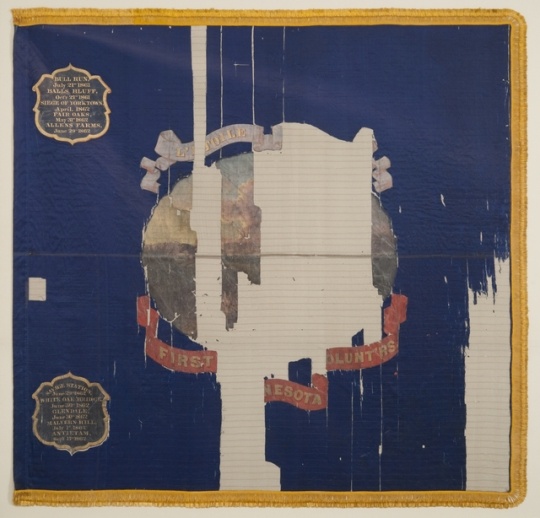
Battle flag of the First Minnesota Volunteer Infantry Regiment
A regimental battle flag of the First Minnesota Volunteer Infantry Regiment, presented to the regiment by Governor Alexander Ramsey in April 1863.
All rights reserved
Holding Location
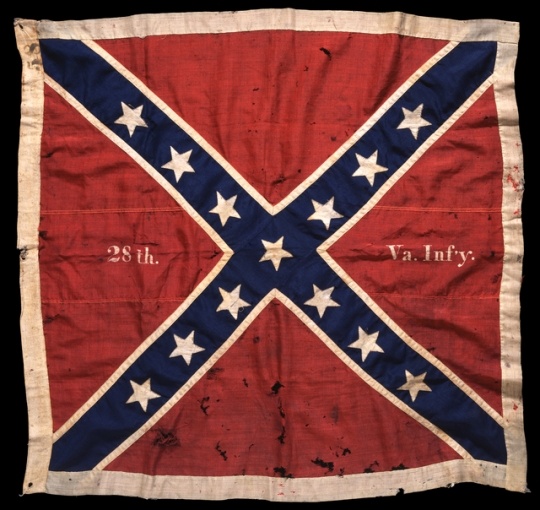
Battle flag of the Twenty-eighth Virginia Volunteer Infantry Regiment
The Army of Northern Virginia Confederate battle flag of the Twenty-eighth Virginia Volunteer Infantry Regiment. Captured by Private Marshall Sherman of St. Paul while serving with the First Minnesota Volunteer Infantry Regiment, Company C, during Pickett's Charge at the Battle of Gettysburg on July 3, 1863.
All rights reserved
Holding Location
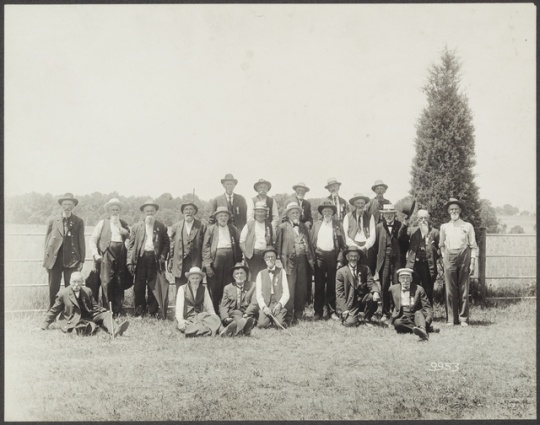
Survivors of the First Minnesota at Gettysburg
Survivors of the First Minnesota at Gettysburg, c.1913. Photograph by W. H. Tipton.
Public domain
Holding Location
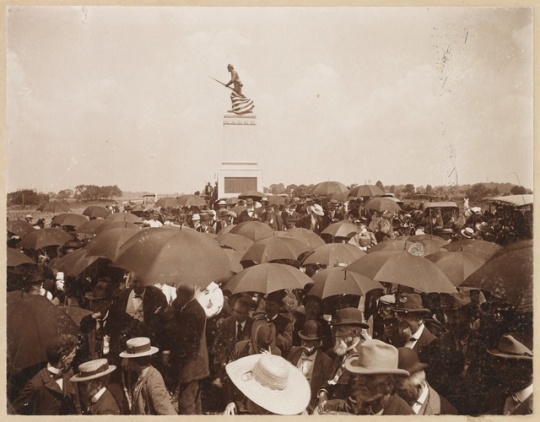
First Minnesota monument at Gettysburg
Crowd gathered for the dedication of the First Minnesota monument at Gettysburg, 1897. Erected by the State of Minnesota on the spot near Cemetery Ridge where, on July 2, 1863, the regiment held the Union line against advancing Confederate soldiers.
Holding Location
Related Articles
Turning Point
On July 2, 1863, at the Battle of Gettysburg in Pennsylvania, the First Minnesota Volunteer Infantry Regiment charges and holds off advancing Confederate soldiers commanded by Cadmus M. Wilcox, but many men of the First Minnesota are killed or wounded as a result.
Chronology
April 14, 1861
April 29, 1861
July 21, 1861
September 16–17, 1862
July 2, 1863
July 3, 1863
November 27–Decem-ber 2, 1863
February 16, 1864
April 28, 1864
Bibliography
Leehan, Brian. Pale Horse at Plum Run: The First Minnesota at Gettysburg. St. Paul: Minnesota Historical Society Press, 2002.
Lochren, William. "Narrative of the First Regiment." In Minnesota in the Civil and Indian Wars, 1861–1865, vol. 1, 1–78. St. Paul: Minnesota Historical Society Press, 2005.
Moe, Richard. The Last Full Measure: The Life and Death of the First Minnesota Volunteers. St. Paul: Minnesota Historical Society Press, 2001.
Related Resources
Primary
First Minnesota Infantry Regiment Letters and Research Files
Manuscript Collection, Minnesota Historical Society, St. Paul
http://www2.mnhs.org/library/findaids/00509.xml
Description: Photocopies and typed transcripts of letters, diaries, reminiscences, newspaper reports, biographical data, obituaries, and other material collected by Richard Moe for The Last Full Measure, his Civil War history of the men of the First Minnesota Infantry Regiment.
Records of Governor Alexander Ramsey, 1860–1863
Minnesota State Archives, Minnesota Historical Society, St. Paul
http://www2.mnhs.org/library/findaids/gov016.xml
Description: Includes accounting records; records concerning both civil and military appointments; letters received; records relating to pardons and other criminal matters; and petitions. There is substantial documentation of military affairs, especially concerning Minnesota regiments in the Civil War and the US-Dakota War of 1862.
Records of the First Minnesota Volunteer Infantry, 1861–1865
Minnesota State Archives, Minnesota Historical Society, St. Paul
http://www2.mnhs.org/library/findaids/adjg006.pdf
Description: From the Office of the Minnesota Adjutant General. Includes a descriptive book, morning reports, orders, a letterbook, post guard reports, proceedings of the regimental council, medical records, and miscellaneous reports of the First Minnesota Volunteer Infantry during the Civil War.
Willis A. Gorman and Family Papers, 1847–1899
Manuscript Collection, Minnesota Historical Society, St. Paul
http://www2.mnhs.org/library/findaids/P1766.xml
Description: Correspondence, business and legal papers, a volume relating to the Fourth Regiment of the Indiana Infantry, and miscellaneous papers relating to the family of Willis A. Gorman, a Minnesota territorial governor and a colonel (1861-1863) in the First Minnesota Volunteer Infantry.
P615
Regimental Records, Minnesota Infantry Regiment, 1st (1861–1864)
Manuscripts Notebooks Collection, Minnesota Historical Society, St. Paul
Description: Regimental record books and miscellany; records of companies B, C, D, and G.
Secondary
Carley, Kenneth. Minnesota in the Civil War: An Illustrated History. St. Paul: Minnesota Historical Society Press, 2000.
Hage, Anne A. "The Battle of Gettysburg as Seen by Minnesota Soldiers." Minnesota History 38 no. 6 (June 1963): 245–257
http://collections.mnhs.org/mnhistorymagazine/articles/38/v38i06p245-257.pdf
Longacre, Edward G., ed. " 'Indeed We Did Fight': A Soldier's Letters Describe the First Minnesota Regiment Before and During the First Battle of Bull Run." Minnesota History 47, no. 2 (Summer 1980): 63–70.
http://collections.mnhs.org/MNHistoryMagazine/articles/47/v47i02p063-070.pdf
Osman, Stephen E. "Minnesota in the Civil War, 1861–1866: A Bibliography of Published Sources." Unpublished manuscript, 2006.
http://www2.mnhs.org/library/findaids/lb00051/lb00051-000001.pdf
Roberts, Kate. Minnesota 150: The People, Places, and Things that Shape Our State. St. Paul: Minnesota Historical Society Press, 2007.
Smith, Hampton. "Resources for Civil War History at the Minnesota Historical Society." Unpublished manuscript, 1998.
http://collections.mnhs.org/cms/web5/media.php?pdf=1&irn=10169771
Wright, James A. No More Gallant a Deed: A Civil War Memoir of the First Minnesota Volunteers, edited by Steven J. Keillor. St. Paul: Minnesota Historical Society Press, 2001.
Web
The Historic Fort Snelling. The Civil War (1861–1865).
http://www.historicfortsnelling.org/history/military-history/civil-war
Minnesota Historical Society. Civil War Programs.
Originally found at: http://sites.mnhs.org/civil-war/
Minnesota Historical Society. Research Guide: First Minnesota Infantry.
http://libguides.mnhs.org/first_infantry
Minnesota Historical Society. The Battle Flags of Minnesota.
Originally found at: http://collections.mnhs.org/battleflags/














